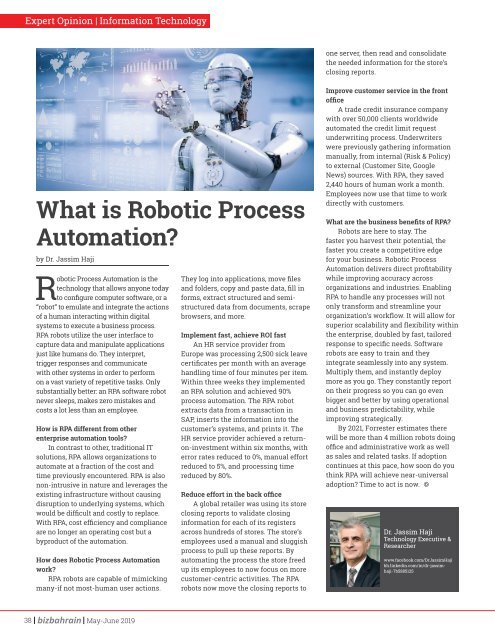Create successful ePaper yourself
Turn your PDF publications into a flip-book with our unique Google optimized e-Paper software.
Expert Opinion | Information Technology<br />
one server, then read and consolidate<br />
the needed information for the store’s<br />
closing reports.<br />
What is Robotic Process<br />
Automation?<br />
by Dr. Jassim Haji<br />
Robotic Process Automation is the<br />
technology that allows anyone today<br />
to configure computer software, or a<br />
“robot” to emulate and integrate the actions<br />
of a human interacting within digital<br />
systems to execute a business process.<br />
RPA robots utilize the user interface to<br />
capture data and manipulate applications<br />
just like humans do. They interpret,<br />
trigger responses and communicate<br />
with other systems in order to perform<br />
on a vast variety of repetitive tasks. Only<br />
substantially better: an RPA software robot<br />
never sleeps, makes zero mistakes and<br />
costs a lot less than an employee.<br />
How is RPA different from other<br />
enterprise automation tools?<br />
In contrast to other, traditional IT<br />
solutions, RPA allows organizations to<br />
automate at a fraction of the cost and<br />
time previously encountered. RPA is also<br />
non-intrusive in nature and leverages the<br />
existing infrastructure without causing<br />
disruption to underlying systems, which<br />
would be difficult and costly to replace.<br />
With RPA, cost efficiency and compliance<br />
are no longer an operating cost but a<br />
byproduct of the automation.<br />
How does Robotic Process Automation<br />
work?<br />
RPA robots are capable of mimicking<br />
many-if not most-human user actions.<br />
They log into applications, move files<br />
and folders, copy and paste data, fill in<br />
forms, extract structured and semistructured<br />
data from documents, scrape<br />
browsers, and more.<br />
Implement fast, achieve ROI fast<br />
An HR service provider from<br />
Europe was processing 2,500 sick leave<br />
certificates per month with an average<br />
handling time of four minutes per item.<br />
Within three weeks they implemented<br />
an RPA solution and achieved 90%<br />
process automation. The RPA robot<br />
extracts data from a transaction in<br />
SAP, inserts the information into the<br />
customer’s systems, and prints it. The<br />
HR service provider achieved a returnon-investment<br />
within six months, with<br />
error rates reduced to 0%, manual effort<br />
reduced to 5%, and processing time<br />
reduced by 80%.<br />
Reduce effort in the back office<br />
A global retailer was using its store<br />
closing reports to validate closing<br />
information for each of its registers<br />
across hundreds of stores. The store’s<br />
employees used a manual and sluggish<br />
process to pull up these reports. By<br />
automating the process the store freed<br />
up its employees to now focus on more<br />
customer-centric activities. The RPA<br />
robots now move the closing reports to<br />
Improve customer service in the front<br />
office<br />
A trade credit insurance company<br />
with over 50,000 clients worldwide<br />
automated the credit limit request<br />
underwriting process. Underwriters<br />
were previously gathering information<br />
manually, from internal (Risk & Policy)<br />
to external (Customer Site, Google<br />
News) sources. With RPA, they saved<br />
2,440 hours of human work a month.<br />
Employees now use that time to work<br />
directly with customers.<br />
What are the business benefits of RPA?<br />
Robots are here to stay. The<br />
faster you harvest their potential, the<br />
faster you create a competitive edge<br />
for your business. Robotic Process<br />
Automation delivers direct profitability<br />
while improving accuracy across<br />
organizations and industries. Enabling<br />
RPA to handle any processes will not<br />
only transform and streamline your<br />
organization’s workflow. It will allow for<br />
superior scalability and flexibility within<br />
the enterprise, doubled by fast, tailored<br />
response to specific needs. Software<br />
robots are easy to train and they<br />
integrate seamlessly into any system.<br />
Multiply them, and instantly deploy<br />
more as you go. They constantly report<br />
on their progress so you can go even<br />
bigger and better by using operational<br />
and business predictability, while<br />
improving strategically.<br />
By 2021, Forrester estimates there<br />
will be more than 4 million robots doing<br />
office and administrative work as well<br />
as sales and related tasks. If adoption<br />
continues at this pace, how soon do you<br />
think RPA will achieve near-universal<br />
adoption? Time to act is now.<br />
Dr. Jassim Haji<br />
Technology Executive &<br />
Researcher<br />
www.facebook.com/DrJassimHaji<br />
bh.linkedin.com/in/dr-jassimhaji-7b5885125<br />
38 <strong>May</strong>-<strong>June</strong> <strong>2019</strong>
















